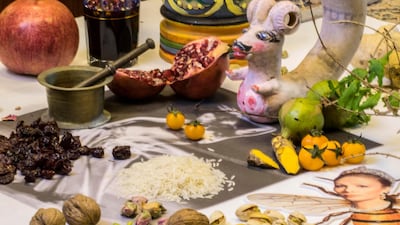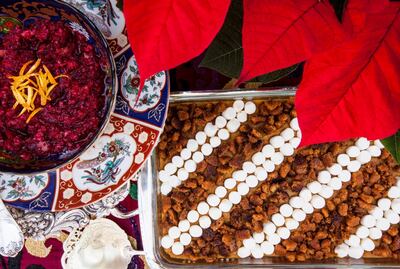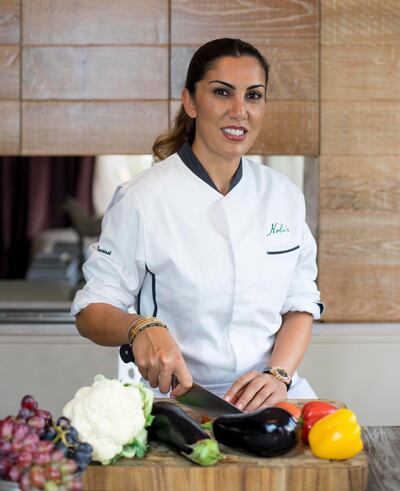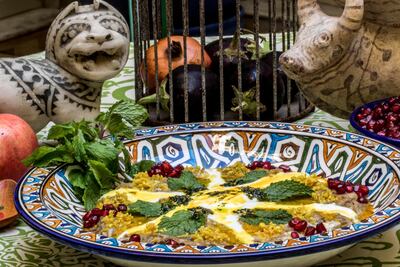In the four exclusive extracts from Table Tales that follow, Hanan Sayed Worrell writes about some of the special people she has met in Abu Dhabi and shares the recipes they provided for her book.
Paula Al Askari, hostess, Lebanon-US
Despite having known Paula for two decades, I still marvel at the environment she has created in her home each time I visit. Crossing her threshold is like entering a world that is part Venetian Settecento, part Ottoman luxe – a rich mélange of dazzling patterns, luxurious textures, and enticing perfumes, stimulating all the senses. It was dubbed “Palazzo Paula”.
She vividly recounts her first impressions of a city she now fondly calls home: “I arrived in Abu Dhabi in 1985 from Paris, where I lived in the 7th arrondissement, the antique quarter. I remember looking out my window and seeing a “greige” sky, the colour of the desert. Many areas were not paved yet. I would step out of the car into a pile of sand. I thought, how am I going to live here?” Paula’s sensitivity to colour led her to create a domestic environment that would speak to her many senses and balance what the external elements could not offer at the time. It was not unusual for a summer holiday in Istanbul, London, or Peru to result in a container full of antiques destined for Abu Dhabi.
Paula presides with radiant beauty on the stage she has created, inviting friends and family to partake in carefully curated feasts and gatherings. The piece de resistance on this stage is the meal
itself, prepared with the same masterly bravura as the surroundings. “I come up with menus that are a fusion of flavours with unexpected combinations, to reflect my sensibilities,” Paula tells me.
Recipe: Spiced sweet potatoes with marshmallows
Serves 8 to 10 as a side dish
Paula: “This is a deliciously decadent seasonal treat from the American South that I am probably genetically predisposed to, having been born in Vicksburg, Mississippi. I make it once a year at Christmas and indulge in the aroma of the holiday spices. I recently added the ginger snaps, which give the mashed potatoes and gooey marshmallows a crunchy texture. I use the Indian sweet potatoes because they are not too fibrous and watery. When I can find it, I add a teaspoon of Marks and Spencer Mixed Spice blend.”
Ingredients
2kg sweet potatoes; 8-10 ginger snap cookies; 1 tbsp grated orange peel; 55g butter, melted, divided; 50g brown sugar, to taste; 1 tsp ginger; 2 tsp cinnamon; ½ tsp cloves; ½ tsp freshly grated nutmeg; ½ tsp salt; 140g small marshmallows
Method
- Preheat the oven to 180°C.
- Wash the potatoes, wrap each in foil, and bake until done, about one-and-a-half hours. While the potatoes are baking, break the gingersnaps in pieces and saute in a small skillet with one tablespoon of the melted butter.
- Leave the oven on after the potatoes are baked.
- Peel and mash the potatoes while warm, preferably with a hand masher. Drain off any excess liquid.
- In a large bowl, add the mashed potatoes, orange peel, the remaining melted butter, brown sugar, ginger, cinnamon, cloves, nutmeg, and salt. Mix well. Transfer to a 26 x 18cm ovenproof dish and spread evenly.
- Decorate the sweet potatoes with the marshmallows and cookie pieces. Bake for 20 minutes. Turn on the broiler for the last few minutes so the marshmallows are toasted.
Marjon Ajami, restaurateur, Afghanistan-US
In 2004, Marjon left the cool, rolling fog of San Francisco and moved to hot and humid Abu Dhabi. During our morning walks, she would share with me her frustration at moving from the Golden Gate City. Those of us who met Marjon – a new mother uneasy about leaving friends and family – could never have predicted the transformation. Food and hospitality are central to Marjon’s life. Her parents emigrated from Kabul to San Francisco in the late 1970s,
and her mother opened an Afghan restaurant in their new hometown. Marjon was raised in her mother’s kitchen with the delectable flavours of qabili pallow (lamb shanks with Afghan brown rice), mantoo (beef dumplings in a yoghurt tomato sauce), and borani kadoo (squash with apricots and yoghurt sauce), along with the fresh and healthy cuisine of Northern California. As she came to terms with her new surroundings in Abu Dhabi, her California positivity
kicked in and Marjon decided to investigate what she could do to enhance the city’s food. “Many of the restaurants lacked soul. I wanted to do something different – to contribute to the city and have the freedom to create dishes that responded to what people living here wanted to eat. It was a struggle, but today I am so proud to see what is available compared to a decade back,” Marjon recalls. Nolu’s Cafe opened in Al Bandar at Raha Beach in 2012, offering California-style cuisine
with an Afghan twist. The cooking reflects simple, health-conscious food with complex flavours introduced in a wholesome way. The open kitchen, pop music, generous portions, and child-friendly atmosphere bring soul to Nolu’s; two other outlets have since opened in the city. The blending of options at Nolu’s, named after the combination of Marjon’s children’s names, is much like Abu Dhabi: a mix of different cultures and cuisines, both traditional and contemporary.
Recipe: Cauliflower and roasted beetroot salad with tahini dressing
Serves 4 to 6
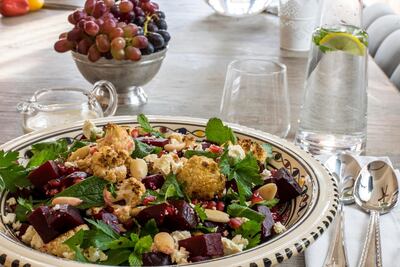
Marjon: "This is a vibrant, hearty salad for all seasons. I much prefer roasting the beetroots to boiling, as the flavours are richer. The tahini dressing and feta cheese beautifully complement the vegetables." Ingredients
1kg cauliflower; 60ml olive oil; Salt, to taste; 450g beetroots; 70g shelled almonds, whole; 15g mint; 15g parsley; 55g feta cheese, crumbled; 75g pomegranate seeds
Dressing
60ml tahini; 60ml lemon juice; 60ml olive oil; 1 tsp salt; 1 tbsp pomegranate molasses
Method
- Preheat oven to 180°C.
- Break the cauliflower into bitesize florets, toss with the olive oil, and sprinkle with salt. Place on a baking tray with sides and roast for 20 to 25 minutes. Set aside on the tray to cool.
- Wrap each beetroot separately with foil and bake for 45 to 60 minutes or until soft when pierced.
- While the vegetables are roasting, soak the almonds in lukewarm water for an hour to soften. Drain when ready to use.
- Combine the dressing ingredients in a blender at medium speed. Add water a tablespoon at a time to thin the dressing as needed, but not so much that the taste is diluted.
- When the beetroots are cooked, unwrap them and let them cool. Peel them and cut into medium-sized cubes. Since the beetroots bleed quite a bit when tossed, combine them with the cauliflower in a large work bowl. Toss with most of the dressing, keeping the rest to serve on the side. Transfer the vegetables to a serving bowl and top with the mint, parsley, and almonds. Sprinkle with the crumbled feta and pomegranate seeds.
Ahmed Al Bawardi, entrepreneur, UAE

Early one December morning, in the midst of hunting season, I set out to meet Ahmed and his friends in the Sweihan desert. Ahmed’s bird, a sakr falcon about 50 centimetres high, speckled brown, with sharp talons, stands hooded on a wooden perch.
Before the training begins we gather around a crackling wood fire to prepare breakfast. One of the men heats the water while another whisks a saffron yellow batter. The light breakfast of chai karak (sweet milk tea) infused with saffron threads and chbaab (Emirati pancakes) drizzled with date molasses gives the men just the right amount of energy for the training session.
With breakfast complete, Ahmed gently transfers his falcon from its perch onto his gloved wrist, stroking her breast and softly murmuring her name, the affection between the two palpable. Ahmed removes the bird’s hood, revealing its piercing round eyes, like shiny black marbles. The bird bolts skyward in search of prey.
Ahmed spent his early years in San Antonio, Texas, where his father was sent by the military for training, and then in Washington, DC, but there were frequent trips back home to Abu Dhabi. While away from the United Arab Emirates, his parents ensured he wouldn’t forget his roots by cooking Emirati food and teaching him to speak Arabic.
“The beauty of a culture like ours is that it is humbling and close to the ground. You always come back to who you are, no matter how far away you go,” Ahmed remarks. For him, maintaining his Bedouin culture, as he hunts for innovative ideas in New York, San Francisco and Los Angeles, is about being part of a progressive nomadic culture. Ahmad refers to this as “the neo-tribe – connoisseurs of nature – global nomads connected by a love for wildlife and suntouched food”.
Recipe: Chbaab (Emirati Pancakes)
Makes 8 to 10
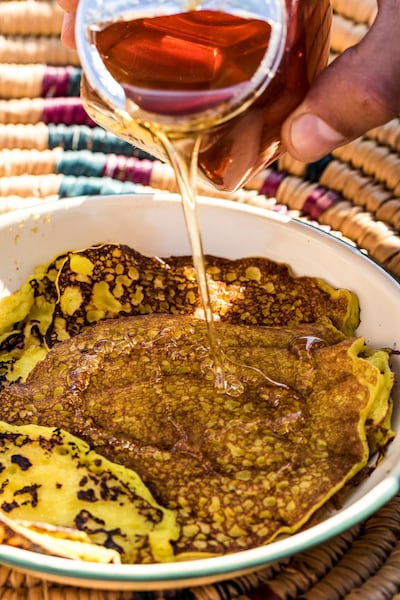
Ahmed: “Chbaab is our pancake, spiced with cardamom and saffron, which gives it a golden colour. It can be made thin like a crepe or thick like an American pancake. I prefer the thinner batter, which brings out the artist in me and allows me to create abstract shapes on the griddle instead of the conventional round chbaab. The batter is prepared at the farmhouse and we then make the chbaab fresh at the campsite over a fire on the multipurpose metal disk known as a tabi. It can be eaten sweet with honey and date molasses or savoury with cheese.”
Ingredients
150g all-purpose flour; 1 tbsp sugar; ½ tsp yeast; ½ tsp baking powder; ¼ tsp salt; ½ tsp ground cardamom; 1 egg, slightly beaten; 240ml milk; 1 tbsp cooking oil; Pinch of saffron; Butter or ghee
Method
- Mix the flour, sugar, yeast, baking powder, salt and cardamom in a small bowl. Whisk the egg, milk, oil, and saffron in a medium bowl. Whisk the dry ingredients into the milk mixture. For a thinner pancake, add more milk. Cover and keep in a warm place for 30 to 45 minutes.
- Heat a griddle or large skillet over medium-high heat. Add a tablespoon of butter or ghee. Pour about 60ml of batter onto the griddle for each pancake. Cook for one to two minutes. Flip and do the same for the other side.
- Serve with honey, date molasses or cheese.
Nazzy Beglari, designer and journalist, Iran-US and Peter Scarlet, film festival director, US
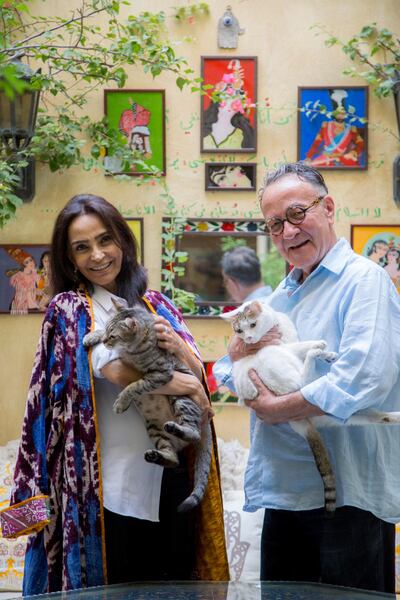
The scene is the awards ceremony for the 2009 edition of Abu Dhabi's international film festival at the opulent Emirates Palace Hotel. The festival's new artistic director, Peter Scarlet, is the host of the star-studded evening. After the award ceremony he introduces the final screening, The Men Who Stare at Goats, and explains to the audience, "Unfortunately, none of the film's stars – George Clooney, Kevin Spacey, Jeff Bridges, or Ewan McGregor – was able to be here tonight. So, since the men who stare at goats are not here, please welcome onstage some of the goats who undoubtedly stared right back at them." At this point, four smiling goatherders lead their charges onstage, to the audience's surprised hilarity.
Scarlet has long been interested in movies from the Middle East and North Africa and was one of the few American film festival directors who actively pursued movies from this region. When he was approached in 2009 to head the film festival in Abu Dhabi, Scarlet felt it was a natural progression to deepen his connection with the region. He talked things over with his wife, Nazzy, who at the time was a senior international correspondent for Voice of America. She had frequently travelled to the region to cover stories, but never to Abu Dhabi. Nazzy was eager to move closer to her birthplace, Iran, which she had left in 1978 to study abroad.
Nazzy incorporates fruit into many of her savoury dishes, a hallmark of Azeri cuisine she learned from her grandmother. Tart cherry rice and pomegranate soup are among Nazzy’s signature offerings. Over several afternoons, Nazzy has patiently taught me the art of rice-making and the delicate balance of opposing impulses in Persian food, such as savoury with sweet and hot with cold. Here, the idea of hot with cold food is not based on spiciness or temperature but on the notion of whether the food creates energy or a cooling effect on the body.
Our conversation often wanders to the idea of “home”, and where we might be at this time next year. For Nazzy, who describes herself as a global nomad, her home is her country, and she recreates it wherever she goes, with food at its heart. Nazzy fondly shares, “My grandmother taught me that a house without an active kitchen is not a home.”
Kashk-e bademjan (aubergine and yoghurt dip)
Serves 4 to 6
Nazzy: I prefer to use thick Greek yoghurt, which has a milder taste than kashk. I enjoy the presentation of this dish as much as the taste. The brownish aubergine mash is a perfect canvas on which to drizzle the yellow saffron, blot the white yoghurt, sprinkle with the crimson pomegranate, and splash with the green mint. So, let your inner artist flow and use your imagination when garnishing. This dish can be served warm or at room temperature as a dip with lavash or pitta bread.
Ingredients
Aubergine base
1.5kg aubergine 120ml water 1 tsp black pepper 2 tbsp dried mint, divided Salt, to taste 60g Greek yoghurt or kashk
Garnish
2 tbsp garlic, diced 1 tbsp olive oil ½ tsp turmeric 1 tbsp dried mint 1 tsp saffron Pinch of sugar Greek yoghurt or kashk Pomegranate seeds
Method
For the aubergine base
- Peel and slice the aubergine into two centimetre-thick slices.
- Sprinkle the slices with salt and leave them in a strainer for 30 minutes; pat dry. Heat the oil in a large skillet over medium heat and fry the aubergine slices in batches until they are golden brown, turning once. [Can also be brushed with olive oil, sprinkled with pepper, dried mint, and salt, and baked at 200°C for 25 minutes or until softened and golden brown.]
- Place the aubergine slices in a medium saucepan and add 120 millilitres (½ cup) water; bring to a boil. Lower the heat and simmer for 10 minutes, until the aubergine is very tender. Mash the aubergine with a fork, leaving some lumps. Sprinkle in the pepper, mint, and salt to taste.
- Continue to simmer on low heat until the water has evaporated; remove from the heat. [This dish can be prepared through this stage a day ahead of time and refrigerated.]
- When the aubergine mash has cooled, stir in 60 grams (¼ cup) of the Greek yoghurt or kashk, mix well and adjust the seasoning to taste.
For the Garnish
- Saute the garlic in the olive oil for two minutes.
- Add the turmeric and stir until the garlic is golden. Remove the garlic from the pan and drain on a paper towel. Remove the pan from the heat and stir the mint into the remaining oil.
- Using a mortar and pestle, crush the saffron with the sugar. Stir in two tablespoons of hot water and set aside for the colour to diffuse.
Serve garnished with dollops of yoghurt or kashk and the sauteed garlic and mint. Drizzle with the saffron liquid and sprinkle with some pomegranate seeds.
__________________________
Read more:
New guide focuses on honest ethical eateries, so which UAE restaurants made the cut?
Kitchen 'gran' central: the taste for family favourites has returned
Fadi Kattan: The Palestinian chef dishing gourmet cuisine under occupation
Is Instagram ruining food? We talk to some of Dubai's top chefs
